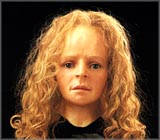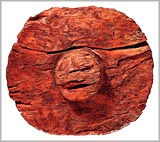 |
The Mysterious Bog People
About the Exhibition
The Mysterious Bog People is the first international
touring exhibition to showcase the wealth of precious objects
deposited in the bogs of northwestern Europe over the course of
10,000 years, and to explore the reasons why these riches -
and even human bodies - were placed in these perilous
wetland environments. In fact, archaeologists believe that the
reasons were spiritual in nature: that the objects were placed
as offerings and the bodies as sacrifices, a gesture to the
spirit world for wishes sought or gratitude expressed.

|
This string of beads was found near Exloo in the Netherlands
in 1881. The ornament dates from the Bronze Age and consists
of beads of tin, faience and amber. The clasp is copper. These
materials came by trade to Exloo and were very valuable. Drents
Museum.
|

|
This bog body is known as "Red Franz",
and was found in 1900 in a bog near Neu Versen (Germany). Found
lying on his back, the man lived sometime between A.D. 200 and
400. How Red Franz looked during his life can, for the moment,
only be imagined. However, his facial reconstruction is currently
underway and will be revealed for the first time in The
Mysterious Bog People. Drents Museum.
|
The bogs of ancient times were mystical and dangerous places,
covering vast expanses of northwestern Europe but inaccessible
in daily life because of the treacherously soft ground. It was
not until peat harvesting and land reclamation activities began
a few hundred years ago that mysterious objects began to be
discovered. These discoveries shed light on the everyday lives,
ideas and spiritual beliefs of ancient peoples. Through more
than 400 artifacts, supported by imaginative audio-visual
presentations and interactive techniques, and situated in a
dramatic setting blending theatre, light and sound, the
exhibition aims to provide visitors with a meaningful experience
of the motives behind these bog offerings and even to encourage
visitors to reflect upon their own beliefs.
The artifacts selected for display tell the story of the people
who lived near the bogs and their culture. They include bog
mummies - and details on the reconstruction of individuals
like the "Yde Girl" using modern forensic science -
and a host of objects found in the bogs, such as flint and
bronze axes, pottery, bronze swords, leather shoes, textiles,
gold coins, jewellery, musical instruments and agricultural
tools.

|
Young female bog body, dubbed "Yde
Girl", from the Netherlands. The remains of this
16-year old child, who lived in the first century A.D., were
discovered in a small bog in 1896, along with remnants of
woollen clothing. The remains of the woollen cord with which she
was strangled can still be seen around her neck. Drents Museum.
|

|
In 1993, professor Richard Neave of Manchester University made
a facial reconstruction of Yde Girl. By means
of CT-scans at the University Hospital of Groningen, a
reconstruction of her skull was modelled into the appearance
she would have had when alive. Drents Museum.
|
The exhibition also features one of the oldest artifacts from a
European bog, the Pesse dugout canoe, which was found in 1955
and has been carbon dated between B.C. 8040 and 7510. It is the
oldest known boat in the world and was made from a Scots pine
with the use of flint axes. This remarkable object serves to
explain what a bog environment is like and how it acts to
preserve organic matter.

|
This dugout canoe made of pine measures almost
three metres in length, and was found in 1955 during
construction of a motorway in a small bog near the Drents
village of Pesse (Netherlands). Radiocarbon-dated to 8500 B.C.,
this Mesolithic vessel is the oldest known in the world. Drents
Museum.
|

|
For many centuries, peat was cut by hand. Very
few bodies or other finds escaped the peat-cutters' notice in
those days. Today, mechanical excavators are used to dig peat,
and there is almost no chance of making archaeological
finds. Drents Museum.
|
In prehistoric times, after the last Ice Age, peat began to
form. In the ages that followed, vast areas were covered by
bogs. People lived on the high, dry land between the bogs.
Dangerous and often foggy places where one could easily get
lost and drown, the bogs were shrouded in mystery. It is easy
to understand why people believed they were inhabited by gods
and spirits, who had control over life and death, health, crops,
cattle and the fate of humans.
Good relations with these powerful beings were essential and
could be maintained through offerings, which were deposited at
the threshold of the dwelling place of the divine. Valuable
items such as grain, antlers, pottery, wheels, weapons and
jewellery were left in the bogs, turning them into immense
reservoirs of gifts. Anything of value could be used as an
offering. Even people were sacrificed to propitiate or thank the
gods.

|
Ceramic jar with a style of decoration identified with the
Funnelbeaker Culture (3400-2850 B.C.). Standing more than 17 cm
high, this vessel was found in the spring of 1931 in a bog near
the Drents village of Weerdinge (Netherlands). Drents Museum.
|

|
Disc-wheel with a diameter of almost 75 cm, carved from a
single piece of wood. This oak wheel was found along with
another in a small bog near Ubbena in the province of Drenthe
(Netherlands). Dated at about 2700 B.C., it is one of the
oldest known wheels in Europe. Drents Museum.
|
In early modern times, people began to exploit the bogs. As
huge quantities of turf were cut for fuel, the gifts that had
been buried for the gods were gradually uncovered.
The main theme of the exhibition is the practice of making
offerings, through which prehistoric people tried to control
their fate. Visitors will be astonished by the wide range of
objects that were carefully laid down in the bogs.
The exhibition also reveals the botanical nature of bogs, which
preserve objects that would decay under normal burial
conditions. The history, biology and preservation properties of
bogs are clearly demonstrated in the exhibition. The technique
of reconstruction using modern forensic science is also
examined. Scientists such as Richard Neave, an artist
specializing in facial reconstruction, can recreate facial
features from a skull that is very well preserved. Using clay
and wax, the tissues and skin are modelled on a copy of the
skull. Other facial features such as eyes and hair are also
added, giving an impression of what the individual looked
like.

|
Nederfrederiksmose Body - This body,
discovered in 1898, is the first such body to have been
photographed in situ, - that is, at the site it came to
light. Drents Museum.
|

|
Peat moss (sphagnum) is able to store rainwater and make the
bogs independent of groundwater. Bogs need a
lot of precipitation (a minimum of 700 mm/year) in order to
grow (approximately 1-10 mm/year). Drents Museum.
|
The exhibition also explores the scientific techniques and
forensic analysis used to determine the age of the objects found
in the bogs of northwestern Europe. The scientific component of
the exhibition places it at the leading edge of international
archaeological discovery about prehistoric Europe. Forensic
research was recently conducted on another of the bog mummies of
the Niedersächsisches Landesmuseum, dubbed "Red
Franz," producing a lot of information about his life and
death. Like other bog mummies, "Red Franz" was killed.
This evidence supports the "offering" theory -
that the bogs were indeed centres of spiritual activity and
significance to early Northern Europeans.
The Mysterious Bog People is a unique exhibition.
Never before have so many bog mummies and offerings been
brought together, providing valuable insight into the practices
of our ancestors.
Among the prehistoric persons that visitors will encounter are
Red Franz, found in 1900 in Germany, and a 16-year-old girl from
Yde, discovered three years earlier in the Netherlands.
Fans of Vincent Van Gogh also have a rare opportunity to see a
painting that captures the often desolate atmosphere of the
bogs.
Exhibition Products
- An illustrated book has been produced in four languages:
English, French, Dutch and German. It is available for sale at
the CMC Boutique.
- A variety of products are also on sale at the CMC Boutique:
books and movies, jewellery, giftware, postcards and much
more.
|

